Black & Decker LST540 User Manual

40v Max* Lithium Trimmer/Edger
INSTRUCTION MANUAL
Catalog Number
LST540
Thank you for choosing Black+Decker!
Please read before returning this product for any reason.
If you have a question or experience a problem with your Black+Decker purchase, go to http://www.blackanddecker.com/instantanswers
If you can’t find the answer or do not have access to the Internet, call 1-800-544-6986 from 8 a.m. to 5 p.m. EST Mon. - Fri. to speak with an agent.
Please have the catalog number available when you call.
Save this manual for future reference.
VEA EL ESPANOL EN LA CONTRAPORTADA.
INSTRUCTIVO DE OPERACIÓN, CENTROS DE SERVICIO Y PÓLIZA DE GARANTÍA.
ADVERTENCIA: LÉASE ESTE INSTRUCTIVO ANTES DE USAR EL PRODUCTO.
*Maximum initial battery pack voltage (measured without a workload) is 40 volts. The nominal voltage is 36.
KEY INFORMATION YOU SHOULD KNOW:
•The guard must be installed before trimming or edging - if not, the motor will overheat (page 7).
•When replacing the line, use only .080 inch diameter ROUND line (B+D Model #SF-080 is recommended) - otherwise the appliance will not function properly (page 10).
•Do not bump the feed head against the ground - it will disrupt the feed mechanism.
•For use only with lithium-ion 36v or 40v Max* batteries.
To register your new product, visit www.BlackandDecker.com/NewOwner

SAFETY GUIDELINES - DEFINITIONS
It is important for you to read and understand this manual. The information it contains relates to protecting YOUR SAFETY and PREVENTING PROBLEMS. The symbols below are used to help you recognize this information.
 DANGER: Indicates an imminently hazardous situation which, if not avoided, will result in death or serious injury.
DANGER: Indicates an imminently hazardous situation which, if not avoided, will result in death or serious injury.
 WARNING: Indicates a potentially hazardous situation which, if not avoided, could result in death or serious injury.
WARNING: Indicates a potentially hazardous situation which, if not avoided, could result in death or serious injury.
 CAUTION: Indicates a potentially hazardous situation which, if not avoided, may
CAUTION: Indicates a potentially hazardous situation which, if not avoided, may
result in minor or moderate injury.
NOTICE: Used without the safety alert symbol indicates potentially hazardous situation which, if not avoided, may result in property damage.
Important Safety Warnings
 WARNING: When using electric gardening appliances, basic safety precautions should always be followed to reduce risk of fire, electric shock, and personal injury, including the following.
WARNING: When using electric gardening appliances, basic safety precautions should always be followed to reduce risk of fire, electric shock, and personal injury, including the following.
Read All Instructions
•ALWAYS WEAR EYE PROTECTION –
Wear safety spectacles or goggles at all times when battery is installed. These items are available for purchase.
•GUARD – Do not use this appliance without guard attached.
•DRESS PROPERLY – Do not wear loose clothing or jewelry. They can be caught in moving parts. Gloves and substantial rubber soled footwear are recommended when working outdoors. Don’t operate the appliance when barefoot or wearing open sandals. Wear heavy long pants to protect your legs. Wear protective hair covering to contain long hair.
•NYLON LINE – Keep face, hands and feet clear of rotating nylon line at all times.
•THE ROTATING LINE PERFORMS A CUTTING FUNCTION – Use care when trimming around screens and desirable plantings.
•KEEP ALL BYSTANDERS AWAY – at a safe distance from work area, especially children.
•IMPORTANT WARNING – When being used as an Edger, stones, pieces of metal and other objects can be thrown out at high speed by the line. The appliance and guard are designed to reduce the danger. However, the following special precautions should be taken: MAKE SURE that other persons and pets are at least 100 feet (30m) away.
•TO REDUCE THE RISK of rebound (ricochet) injury, work going away from any nearby solid object such as wall, steps,
large stone, tree, etc. Use great care when working close to solid objects and where necessary, do trimming by hand.
• AVOID ACCIDENTALLY STARTING –
Don’t carry with finger on trigger when battery is installed.
• USE THE RIGHT appliance – Do not use this appliance for any job except that for which it is intended.
• DON’T OVERREACH – Keep proper footing and balance at all times.
• Don’t Force Appliance – It will do the job better and with less likelihood of a risk of injury at the rate for which it was designed
• DAMAGE TO UNIT – If you strike or become entangled with a foreign object, stop appliance immediately, remove battery, check for damage and have any damage repaired before further operation is attempted. Do not operate with a broken hub or spool.
• REMOVE BATTERY – when not in use, when replacing line, or prior to cleaning.
• AVOID DANGEROUS ENVIRONMENTAL CONDITIONS – Do not use electric appliances in damp or wet locations. Follow all instructions
in this Instruction Manual for proper operation of your appliance. Don’t use the appliance in the rain.
• DO NOT OPERATE portable electric appliances in gaseous or explosive atmospheres. Motors in these appliances normally spark, and the sparks might ignite fumes.
• STORE IDLE applianceS INDOORS
– When not in use, appliances should be stored indoors in a dry, locked-up place out of reach of children.
• STAY ALERT – Do not operate this unit when you are tired, ill, or under the influence of alcohol, drugs, or medication.
• MAINTAIN APPLIANCES WITH CARE
– Follow instructions in maintenance section. Keep handles dry, clean and free from oil and grease.
2
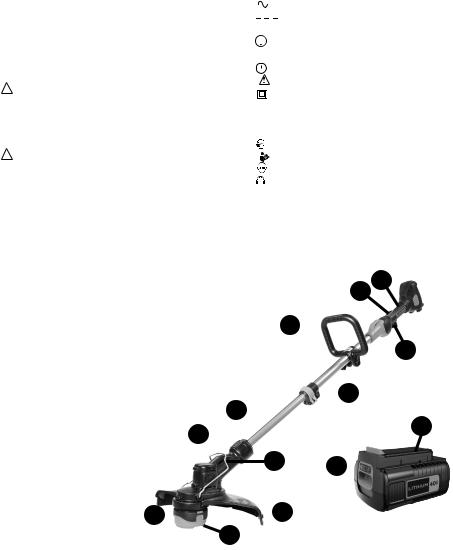
• CHECK DAMAGED PARTS – Before further use of the appliance, a guard or other part that is damaged should be carefully checked to determine that it will operate properly and perform its intended function. Check for alignment of moving parts, binding of moving parts, breakage of parts, mounting, and any other condition that may affect its operation. A guard
or other part that is damaged should be properly repaired or replaced by an
authorized service center unless otherwise indicated elsewhere in this manual.
• DO NOT immerse appliance in water or squirt it with a hose. DO NOT allow any liquid to get inside it. If appliance does get wet, allow to dry for a minimum of 48 hours.
• DO NOT store the appliance on or adjacent to fertilizers or chemicals.
• DO NOT clean with a pressure washer.
• Keep guards in place and in working order.
• Keep hands and feet away from cutting area.
• Do not charge appliance in rain, or in wet locations
 WARNING: Do not use appliance if the switch trigger does not turn the appliance on or off. Any appliance that can not be controlled with the switch trigger is dangerous and must be repaired.
WARNING: Do not use appliance if the switch trigger does not turn the appliance on or off. Any appliance that can not be controlled with the switch trigger is dangerous and must be repaired.
 WARNING: Some dust created by this product contains chemicals known to the State of California to cause cancer, birth defects or other reproductive harm. Some examples of these chemicals are:
WARNING: Some dust created by this product contains chemicals known to the State of California to cause cancer, birth defects or other reproductive harm. Some examples of these chemicals are:
• compounds in fertilizers
• compounds in insecticides,
|
|
|
herbicides and pesticides |
||
|
|
|
• arsenic and chromium from |
||
|
|
|
chemically treated lumber |
||
To reduce your exposure to these |
|||||
chemicals, wear approved safety equipment |
|||||
such as dust masks that are specially |
|||||
designed to filter out microscopic particles. |
|||||
• The label on your appliance may include |
|||||
the following symbols. The symbols and |
|||||
their definitions are as follows: |
|||||
V.................. |
volts |
||||
mW.............. |
milliwatts |
||||
nm................ |
wavelength in nonometers |
||||
A.................. |
amperes |
||||
Hz................ |
hertz |
||||
W................. |
watts |
||||
min............... |
minutes |
||||
|
|
|
or AC...... |
alternating current |
|
|
|
|
|
or DC.... |
direct current |
|
|
|
|
||
no................. |
no load speed |
||||
|
|
|
................. |
|
Class I Construction |
|
|
|
|
|
|
|
|
|
|
|
(grounded) |
|
|
|
................. |
|
earthing terminal |
|
|
|
|
|
|
|
|
|
................ |
|
safety alert symbol |
|
|
|
................. |
|
Class II Construction |
.../min or rpm |
(double insulated) |
||||
revolutions or |
|||||
|
|
|
|
|
reciprocation per minute |
|
|
|
.................. |
|
Use proper respiratory protection |
|
|
|
|
.................. |
Read instruction manual before use |
|
|
|
................. |
|
Use proper eye protection |
|
|
|
................... |
|
Use proper hearing protection |
Functional Description
1. |
Variable speed trigger |
|
|
|
|
|
|
|
|
|
3 2 |
||||
2. |
Handle |
|
|
|
|
|
|
|
|
|
|||||
3. |
Lock off button |
|
6 |
|
|
|
|
|
|
||||||
4. |
Battery |
|
|
1 |
|||||||||||
|
|
|
|
|
|
|
|
|
|||||||
5. |
Charge indicator |
|
|
|
|
|
|
|
|
|
|||||
|
|
|
|
|
|
|
|
|
|
|
|
|
|
||
6. |
Auxiliary handle |
|
|
|
|
|
|
|
|
|
|
|
7 |
|
|
7. |
Height adjust locking |
|
9 |
|
|
|
|
|
|
||||||
|
|
|
|
|
|
|
|
|
|||||||
|
clamp |
|
|
|
|
4 |
|||||||||
8. |
Trimmer head |
|
8 |
|
|
|
|
|
|||||||
|
|
|
|
|
|
|
|
|
|
|
|||||
9. |
Head rotate button |
|
|
|
|
|
10 |
|
5 |
|
|
||||
|
|
|
|
|
|
|
|||||||||
10. Edge guide |
|
|
|
|
|
|
|
|
|
|
|
|
|
|
|
11. Guard |
12 |
|
|
|
|
|
|
11 |
|
|
|
|
|
|
|
12. Spool housing |
|
|
|
|
|
|
|
|
|
|
|
|
|||
13. Spool cap |
13 |
|
3

iMPORtANt SAFEtY
iNStRuCtiONS FOR BAttERY
ChARGERS
SAVE THESE INSTRUCTIONS: This manual contains important safety instructions for battery chargers.
• Before using charger, read all instructions and cautionary markings on charger, battery pack, and product using battery pack.
 WARNING: Shock hazard. Do not allow any liquid to get inside charger.
WARNING: Shock hazard. Do not allow any liquid to get inside charger.
 CAUTION: Burn hazard. To reduce the risk of injury, charge only designated Black+Decker batteries. Other types of batteries may burst causing personal injury and damage.
CAUTION: Burn hazard. To reduce the risk of injury, charge only designated Black+Decker batteries. Other types of batteries may burst causing personal injury and damage.
 CAUTION: Under certain conditions, with the charger plugged in to the power supply, the charger can be shorted by foreign material. Foreign materials of a conductive nature such as, but not limited to, steel wool, aluminum foil, or any buildup of metallic particles should be kept away from charger cavities. Always unplug the charger from the power supply when there is no battery pack in the cavity. Unplug charger before attempting to clean.
CAUTION: Under certain conditions, with the charger plugged in to the power supply, the charger can be shorted by foreign material. Foreign materials of a conductive nature such as, but not limited to, steel wool, aluminum foil, or any buildup of metallic particles should be kept away from charger cavities. Always unplug the charger from the power supply when there is no battery pack in the cavity. Unplug charger before attempting to clean.
WARNING:
• DO NOT attempt to charge the battery pack with any chargers other than the ones in this manual.
The charger and battery pack are specifically designed to work together.
• These chargers are not intended for any uses other than charging designated Black+Decker rechargeable batteries. Any other uses may result in risk of fire, electric shock or electrocution.
• Do not expose charger to rain or snow.
• Pull by plug rather than cord when disconnecting charger. This will reduce risk of damage to electric plug and cord.
• Make sure that cord is located so that it will not be stepped on, tripped over, or otherwise subjected to damage or stress.
• Do not use an extension cord unless it is absolutely necessary. Use of improper extension cord could result in risk of fire, electric shock, or electrocution.
• An extension cord must have adequate wire size (AWG or American Wire Gauge) for safety. The smaller the gauge number of the wire, the greater the capacity of the cable, that is 16 gauge has more capacity than 18 gauge. When using more than one extension to make up the total length, be sure each individual extension contains at least the minimum wire size.
Recommended Minimum Wire Size
for Extension Cords
|
|
Minimum Gage for Cord Sets |
|
||
Volts |
|
Total Length of Cord in Feet |
|||
120V |
|
0-25 |
26-50 |
51-100 |
101-150 |
|
|
(0-7,6m) (7,6-15,2m) |
(15,2-30,4m) |
(30,4-45,7m) |
|
Ampere Rating |
|
American Wire Gage |
|||
More Not more |
|
||||
Than |
Than |
18 |
16 |
16 |
14 |
0 |
-6 |
||||
6 |
-10 |
18 |
16 |
14 |
12 |
10 |
-12 |
16 |
16 |
14 |
12 |
12 |
-16 |
14 |
12 |
Not Recommended |
|
|
|
|
|
|
|
•Do not place any object on top of charger or place the charger on a soft surface that might block the ventilation slots and result in excessive internal heat. Place the
charger in a position away from any heat source. The charger is ventilated through slots in the top and the bottom of the housing.
•Do not mount charger on wall or permanently affix charger to any surface. The charger is intended to use on a flat, stable surface (i.e., table top, bench top).
•Do not operate charger with damaged cord or plug — have them replaced immediately.
•Do not operate charger if it has received a sharp blow, been dropped, or otherwise damaged in any way. Take it to an authorized service center.
•Do not disassemble charger; take it to an authorized service center when service or repair is required. Incorrect reassembly may result in a risk of electric shock, electrocution or fire.
•Disconnect the charger from the outlet before attempting any
cleaning. This will reduce the risk of electric shock. Removing the battery pack will not reduce this risk.
•NEVER attempt to connect 2 chargers together.
•The charger is designed to operate on standard household electrical power (120 Volts). Do not attempt to use it on any other voltage.
Important safety InstructIons for battery packs
 WARNING: For safe operation, read this manual and manuals originally supplied with appliance before using the charger.
WARNING: For safe operation, read this manual and manuals originally supplied with appliance before using the charger.
The battery pack is not fully charged out of the carton. Before using the battery pack and charger, read the safety instructions below. Then follow charging procedures outlined.
Read all Instructions
4
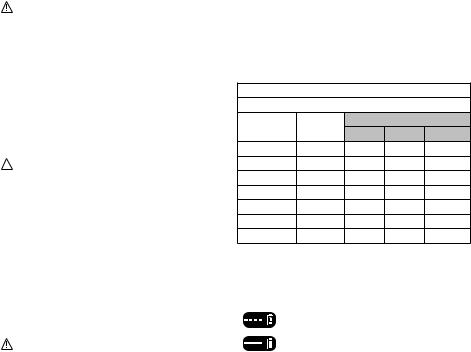
• Do not incinerate the battery pack even if it is severely damaged or is completely worn out. The battery
pack can explode in a fire. Toxic fumes and materials are created when battery packs are burned.
• Do not charge or use battery in explosive atmospheres, such as in the presence of flammable liquids, gases or dust. Inserting or removing the battery from the charger may ignite the dust or fumes.
• If battery contents come into contact with the skin, immediately wash area with mild soap and water. If battery liquid gets into the eye, rinse water over the open eye for 15 minutes or until irritation ceases. If medical attention is needed, the battery electrolyte for Li-ion batteries is composed of a mixture of liquid organic carbonates and lithium salts.
• Contents of opened battery cells may cause respiratory irritation.
Provide fresh air. If symptoms persist, seek medical attention.
• Do not dispose of the battery in a fire. The cell may explode. Check with local codes for possible special disposal instructions.
• Do not open or mutilate the battery.
Released electrolyte is corrosive and may cause damage to the eyes or skin. It may be toxic if swallowed.
WARNING: Burn hazard.
Battery liquid may be flammable if exposed to spark or flame.
• Charge the battery packs only in
Black+Decker chargers.
• DO NOT splash or immerse in water or other liquids. This may cause premature cell failure.
• Do not store or use the appliance and battery pack in locations where the temperature may reach or exceed
105°F (40˚C) (such as outside sheds or metal buildings in summer).
 WARNING: Never attempt to open the battery pack for any reason. If battery pack case is cracked or damaged, do not insert into charger. Do not crush, drop or damage battery pack. Do not use a battery pack or charger that has received a sharp blow, been dropped, run over or damaged in any way (i.e., pierced with a nail, hit with a hammer, stepped on). Damaged battery packs should be returned to service center for recycling.
WARNING: Never attempt to open the battery pack for any reason. If battery pack case is cracked or damaged, do not insert into charger. Do not crush, drop or damage battery pack. Do not use a battery pack or charger that has received a sharp blow, been dropped, run over or damaged in any way (i.e., pierced with a nail, hit with a hammer, stepped on). Damaged battery packs should be returned to service center for recycling.
WARNING: Fire hazard. Do not store or carry battery so that metal objects can contact exposed battery terminals. For
example, do not place battery in aprons, pockets, APPLIANCE boxes, product kit boxes, drawers, etc., with loose nails, screws, keys, etc. Transporting batteries can possibly cause fires if the battery terminals inadvertently come in contact with conductive materials such as keys, coins, hand APPLIANCEs and the like. The US Department of Transportation Hazardous Material Regulations (HMR) actually prohibit transporting batteries in commerce or on airplanes (i.e., packed in suitcases and carry-on luggage) UNLESS they are properly protected from short circuits. So when transporting individual batteries, make sure that the battery terminals are protected and well insulated from materials that could contact them and cause a short circuit. NOTE: Batteries should not be put in checked baggage.
Storage Recommendations
1. The best storage place is one that is cool and dry away from direct sunlight and excess heat or cold.
2. Long-term storage will not harm the battery pack or the charger as long as the battery is not depleted.
Charging Procedure
Black+Decker chargers are designed to charge Black+Decker battery packs.
BLACK+DECKER Battery and Charger Systems
Chargers/Charge Time** (Hours) (0% - 100% charge)
40V MAX* Watt 40V MAX* Chargers Batteries Hours LCS36 LCS40 LCS436
LBX36 |
47 |
1 |
1 |
3.25 |
LBXR36 |
60 |
1.25 |
1.25 |
3.75 |
LBX1540 |
60 |
1.25 |
1.25 |
3.75 |
LBXR2036 |
80 |
1.5 |
1.5 |
5 |
LBX2040 |
80 |
1.5 |
1.5 |
5 |
LBXR2540 |
100 |
1.75 |
1.75 |
6.25 |
LBX2540 |
100 |
1.75 |
1.75 |
6.25 |
**All charge times are approximate. Actual charge time may vary.
1. Plug the charger into an appropriate outlet before inserting the battery pack. 2. Insert the battery pack into the charger.
3. The green LED will flash indicating that the battery is being charged.
4. The completion of charge is indicated by the green LED
remaining on continuously. The pack is fully charged and may be used at this time or left on the charger.
5
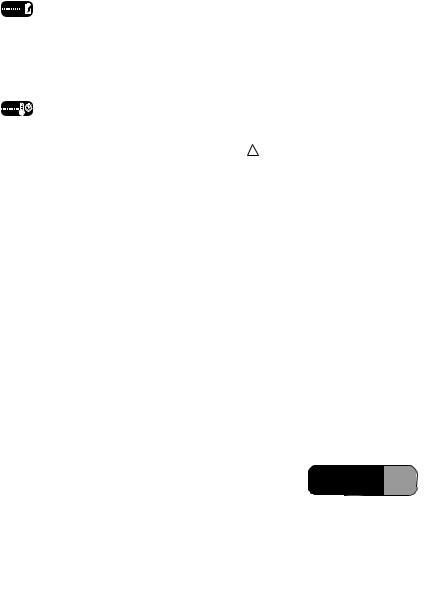
Recharge discharged batteries as soon as possible after use or battery life may be greatly diminished.
Charger Diagnostics
This charger is designed to detect certain problems that can arise with the battery packs or the power source. Problems are indicated by one LED flashing in different patterns.
Bad battery
The charger can detect a weak or damaged battery. The red LED
flashes in the pattern indicated on the label. If you see this bad battery blink pattern, do not continue to charge the battery. Return it to a service center or a collection site for recycling.
Hot/Cold pack delay
When the charger detects a battery that is excessively hot or excessively
cold, it automatically starts a Hot/Cold Pack Delay, suspending charging until the battery has normalized. After this happens, the charger automatically switches to the Pack Charging mode. This feature ensures maximum battery life. The red LED flashes in the pattern indicated on the label when the hot / cold pack delay is detected.
Leaving the battery in the charger
The charger and battery pack can be left connected with the green LED glowing indefinitely. The charger will keep the battery pack fresh and fully charged.
Important Charging Notes
1. Longest life and best performance can be obtained if the battery pack is charged when the air temperature is between 60°F and 80°F (16°- 27°C). DO NOT charge the battery pack in an air temperature below +40°F (+4.5°C), or above +105°F
(+40.5°C). This is important and will prevent serious damage to the battery pack.
2. The charger and battery pack may become warm to touch while charging. This is a normal condition, and does not indicate a problem. To facilitate the cooling of the battery pack after use,
avoid placing the charger or battery pack in a warm environment such as in a metal shed, or an uninsulated trailer.
3. If the battery pack does not charge properly: a. Check current at receptacle by plugging in a lamp or other appliance b. Check to see if receptacle is connected to a light switch which turns power off when you turn out the lights.
c. Move charger and battery pack to a location where the surrounding
air temperature is approximately 60°F - 80°F (16° - 27°C).
d. If charging problems persist, take the appliance, battery pack and charger to your local service center.
4. The battery pack should be recharged when it fails to produce sufficient
power on jobs which were easily done previously. DO NOT CONTINUE to use under these conditions. Follow the charging procedure. You may also charge a partially used pack whenever
you desire with no adverse affect on the battery pack.
5. Foreign materials of a conductive nature such as, but not limited to, steel wool, aluminum foil, or any buildup of metallic particles should be kept away from charger cavities. Always unplug the charger from the power supply when there is no battery pack in the cavity. Unplug charger before attempting to clean.
6. Do not freeze or immerse charger in water or any other liquid.
 WARNING: Shock hazard. Do not allow any liquid to get inside charger. Never attempt to open the battery pack for any reason. If the plastic housing of the battery pack breaks or cracks, return to a service center for recycling.
WARNING: Shock hazard. Do not allow any liquid to get inside charger. Never attempt to open the battery pack for any reason. If the plastic housing of the battery pack breaks or cracks, return to a service center for recycling.
State of charge indicator
The battery is equipped with a state of charge indicator. This can be used to display the current level of charge in the battery while in the trimmer and during charging. It does not indicate
appliance functionality and is subject to variation based on product components, temperature and end-user application.
Checking state of charge during use:
• Press the state of charge indicator button (A1).
• The four LEDs (A2) will illuminate indicating the percent of charge in the battery. See chart in figure A.
• If LED light does not illuminate, charge battery.
A |
A1 |
|
|
|
A2 |


 <18%
<18%


 18% - 45%
18% - 45%


 45% - 72%
45% - 72% 

 72% - 100%
72% - 100%
6
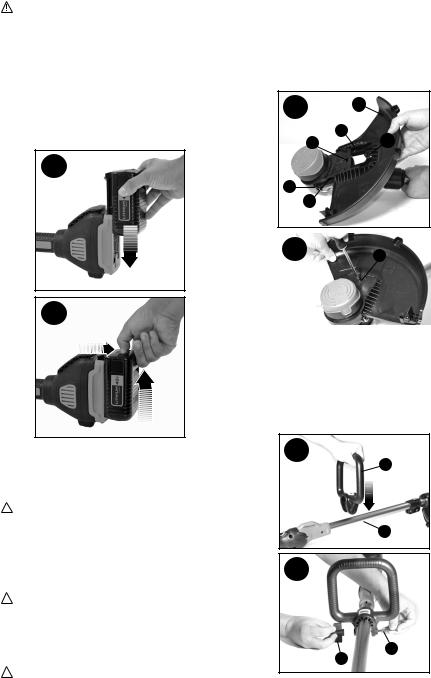
Installing and Removing the
Battery Pack
WARNING: Make sure the switch is not actuated when removing or installing battery.
To install battery pack:
Insert battery pack into trimmer until fully seated and an audible click is heard (figure B). Make sure battery pack is fully seated and fully latched into position.
To remove battery pack: Depress the battery release button in the back of the battery pack and pull battery pack out of trimmer (figure C).
B
C
SAVE THESE INSTRUCTIONS assembly and adjustment
 WARNING: Before assembly, make sure that the APPLIANCE is switched off and the battery has been removed.
WARNING: Before assembly, make sure that the APPLIANCE is switched off and the battery has been removed.
ASSEMBLY TOOLS REQUIRED (NOT SUPPLIED):
- Phillips Screwdriver
 WARNING: Remove the battery before attempting to attach any of the following components.
WARNING: Remove the battery before attempting to attach any of the following components.
Attaching the guard (Figures D and E)
 WARNING: NEVER OPERATE APPLIANCE WITHOUT GUARD FIRMLY IN PLACE. The guard must always be properly attached on the appliance to protect the user.
WARNING: NEVER OPERATE APPLIANCE WITHOUT GUARD FIRMLY IN PLACE. The guard must always be properly attached on the appliance to protect the user.
• Remove the screw from the guard.
•Keeping the guard square to the trimmer head slide it fully into place until the retaining tab clicks into place (Ensure that the guide rails (D1) on the guard (11) are correctly aligned with the guide rails (D2) on the trimmer head (D3) (figure D). The locking tab (D4) should snapped into the housing slot (D5).
•Secure the guard with the screw (E1)
(figure E).
D 11
D1
D4 D5
D3
D2
E |
E1 |
|
|
Attaching the auxiliary handle (figureS F and G)
• Push the auxiliary handle (F1) onto the tube (F2).
• Slide the bolt (G1) through the holes in the auxiliary handle.
• Tighten the knob (G2) onto the bolt by turning it clockwise.
F
F1
F2
G
G1
G2
7
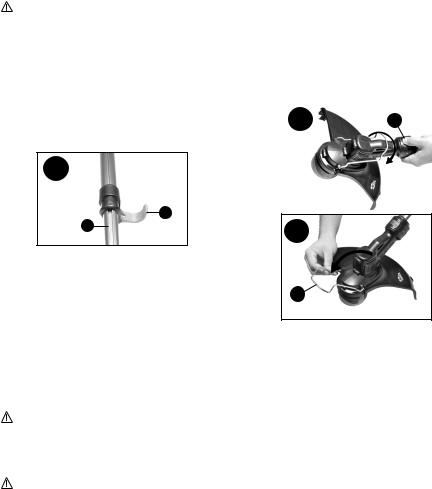
Adjusting the position of the auxilIary handle (fig. G)
The auxiliary handle can be adjusted to provide optimum balance and comfort.
• Loosen the knob on the bolt by turning it counter clockwise.
• Gently slide the auxiliary handle up or down the tube to the desired height.
• Tighten the knob onto the bolt by turning it clockwise.
Adjusting the height (figure H)
CAUTION: Adjust the length of the trimmer to obtain proper working positions as shown in figure M.
• This appliance has a telescopic mechanism, allowing you to set it to a comfortable height.
To adjust the height setting:
• Release the height adjust locking clamp (7).
• Gently pull the bottom tube (H1) up or down to the desired height.
• Close the height adjust locking clamp.
H
7
H1
Releasing the cutting line
In transit, the cutting line is taped to the spool housing.
• Remove the tape holding the cutting line to the spool housing.
Operation
 WARNING: Always use proper eye protection that conforms to ANSI Z87.1 (CAN/CSA Z94.3) while operating this appliance.
WARNING: Always use proper eye protection that conforms to ANSI Z87.1 (CAN/CSA Z94.3) while operating this appliance.
WARNING: Remove the battery before making any assembly, adjustments, or changing accessories. Such preventive safety measures reduce the risk of starting the trimmer accidentally.
CAUTION: Before you begin trimming, only use the appropriate type of cutting line.
 CAUTION: Inspect area to be trimmed and remove any wire, cord, or string-like objects which could become entangled in the rotating line or spool. Be particularly careful to avoid any wire which might be bent outwardly into the path of the trimmer, such as barbs at the base of a chain link fence.
CAUTION: Inspect area to be trimmed and remove any wire, cord, or string-like objects which could become entangled in the rotating line or spool. Be particularly careful to avoid any wire which might be bent outwardly into the path of the trimmer, such as barbs at the base of a chain link fence.
Setting trimming or edging mode
(figure I, J and K)
• The trimmer can be used in trimming mode as shown in figure I or in edging mode to trim overhanging grass along lawn edges and flower beds as shown in figure K.
Trimming mode
For trimming, the trimmer head should be in the position shown in figure I. If it is not:
• Remove the battery from the trimmer.
• Press and hold the head release button (I1).
• While holding the auxillary handle, rotate the head clockwise.
• Release the head release button.
• Lift the edge guide (10) into the closed position.
I |
I1 |
|
|
J
10
Edging mode (figure K)
 WARNING: When being used as an Edger, stones, pieces of metal and other objects can be thrown out at high speed by the line. The trimmer and guard are designed to reduce the danger. However, MAKE SURE that other persons and pets are at least 100 feet (30m) away. For edging, the trimmer head should be in the position shown in figure K. If it is not:
WARNING: When being used as an Edger, stones, pieces of metal and other objects can be thrown out at high speed by the line. The trimmer and guard are designed to reduce the danger. However, MAKE SURE that other persons and pets are at least 100 feet (30m) away. For edging, the trimmer head should be in the position shown in figure K. If it is not:
• Remove the battery from the trimmer.
• Press and hold the head release button (9).
• While holding the auxillary handle, rotate the head counterclockwise.
• Release the head release button.
• Drop the edge guide (10) in to the open position. Ensure that the edging guide is all the way down, an audible click will be heard.
NOTE: The head will only rotate in one direction.
NOTE: The Auto Feed System may not operate correctly if edge guide is not used.
8
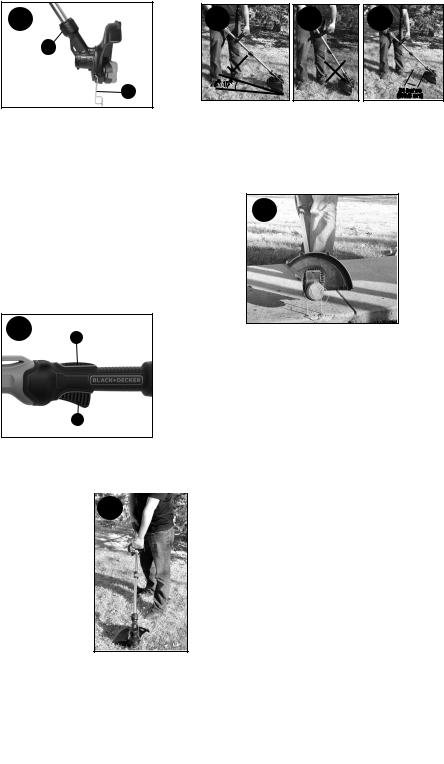
K
9
10
Switching on and off
• To switch the trimmer on, press in and hold the lock off button (3), depress the variable speed trigger (1). The trimmer’s speed, power, and runtime depend on how far you press the switch. Lightly depressing the trigger will result in lower speed and power, but longer runtime. Fully depressing the trigger will result in maximum speed and power, but shorter runtime.
• To switch the trimmer off, release both the trigger and the lock off button.
 WARNING: Never attempt to lock the on/off button in the on position.
WARNING: Never attempt to lock the on/off button in the on position.
L 3
OPERating the Trimmer |
|||
• With the unit on, angle unit and slowly |
|||
|
swing the trimmer side to side as shown |
||
|
in figure M. |
|
|
• |
M |
||
Maintain a cutting |
|||
|
angle of 5° to 10° |
|
|
|
as shown in figure |
|
|
|
M1. Do not exceed |
|
|
|
10°(figure M2). Cut |
|
|
|
with the tip of the line. |
|
|
|
To keep distance |
|
|
|
from hard surfaces |
|
|
|
use edge guide (10). |
|
|
|
Pull the guide out |
|
|
|
until it snaps securely |
|
|
• |
into place |
|
|
Maintain a minimum |
|
||
|
distance of 24 inches (609.6 mm) |
||
|
1 |
|
|
between the guard and your feet as shown in figure M3. To acheive this distance adjust the overall height of the trimmer as shown in figure H.
M1 |
M2 |
M3 |
5O-10O |
|
|
Edging
• Do not use the trimmer to create edges or trenches.
• Guide the trimmer as shown in figure N.
• To make a closer cut, slightly tilt the trimmer.
N
HElpful cutting tips
• Use the tip of the string to do the cutting; do not force string head into uncut grass. Use edge guide along such things as fences, houses and flower beds for best practices.
• Wire and picket fences cause extra string wear, even breakage. Stone and brick walls, curbs, and wood may wear string rapidly.
• Do not allow spool cap to drag on ground or other surfaces.
• In long growth cut from the top down and do not exceed 12 inches (304.8 mm) high.
• Keep trimmer tilted toward the area being cut; this is the best cutting area.
• The trimmer cuts when passing the unit from the right to left. This will avoid throwing debris at the operator.
• Avoid trees and shrubs. Tree bark, wood moldings, siding, and fence posts can easily be damaged by the string.
Cutting Line / LINE FEEDING
Your trimmer uses .080 inch (2.00 mm) diameter, ROUND nylon line. During use, the tips of the nylon lines will become frayed and worn and the special self feeding spool will automatically feed and trim a fresh length of line. Do not bump unit on ground in attempt to feed line or for any other purposes.
Cutting line will wear faster and require more feeding if the cutting or edging is
9

done along sidewalks or other abrasive surfaces or heavier weeds are being cut.
CLEARING JAMS AND TANGLED
LINE (figures O, P, Q)
WARNING: Remove the battery from the trimmer before making any assembly, adjustments or changing accessories. Such preventive safety measures reduce the risk of starting the appliance accidentally. From time to time, especially when cutting thick or stalky weeds, the line feeding hub may become clogged with sap or other material and the line will become jammed as a result. To clear the jam, follow the steps listed below.
• Remove the battery from the trimmer.
• Press the release tabs on the line spool cap, as shown in figure O and remove the cap by pulling it straight off.
O
•Pull the nylon line spool out and clear any broken line or cutting debris from the spool area.
•Place spool and line into spool cap with line “parked” in slots provided as shown in figure P1.
•Insert the line end through the appropriate hole in the spool cap. Pull slack line through until it pulls out of the holding slots as shown in figure P2.
P
P1
P2
•Press the spool down GENTLY and rotate it until you feel it drop into place and then push to snap into place. (When in place, the spool will turn a few degrees left and right freely).
•Take care to keep the line from
becoming trapped under the spool.
• Align the spool cap tabs with the slots on the spool housing (figure P).
• Snap the spool cap back on as shown in figure Q by depressing lugs and pressing into spool housing.
Q
NOTE: Make sure that cover is fully positioned, listen for two audible clicks to ensure both lugs are correctly located. Power the appliance on. In a few seconds or less you’ll hear the nylon line being cut automatically to the proper length.
caution: To avoid appliance damage, if the cutting line protrudes beyond the trimming blade, cut it off so that it just reaches the blade.
NOTE: Other replacement parts (guards, spool caps, etc.) are available through Black+Decker service centers. To find your local service location call: 1-800-544- 6986 or visit www.blackanddecker.com.
WARNING: The use of any accessory not recommended by Black+Decker for use with this appliance could be hazardous.
REPLACING THE SPOOL (figures O,
P, Q, R)
WARNING: Remove the battery from the trimmer before making any assembly, adjustments or changing accessories. Such preventive safety measures reduce the risk of starting the appliance accidentally.
caution: To avoid appliance damage, if the cutting line protrudes beyond the trimming blade, cut it off so that it just reaches the blade.
• Depress the tabs and remove the spool cap from the spool housing on the trimmer head figure O.
• Grasp empty spool with one hand and spool cap with other hand and pull spool out.
• Replace spool with Black+Decker model # SF-080.
• Remove any dirt and grass from the spool and spool cap.
• If lever (R1) in base of spool cap
10
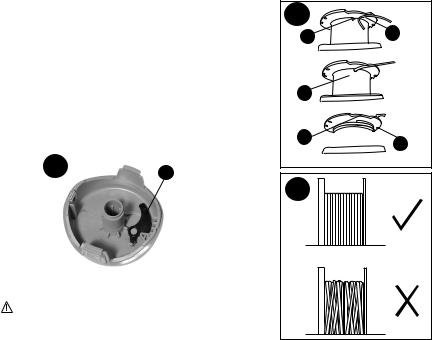
becomes dislodged, replace in correct position before inserting a new spool as shown in figure R.
• Unfasten the end of the cutting line and guide the line into the eyelet (P2).
• Press the spool GENTLY into the spool cap and rotate it until you feel it drop into place. Then push to snap into place. (When in place, the spool will turn a few degrees left and right freely).
• Take care to keep the line from becoming trapped under the spool.
• Align the spool cap tabs with the slots on the spool housing (figure Q).
• Snap the spool cap back on as shown in figure Q by depressing lugs and pressing into spool housing.
NOTE: The line should protrude approximately 4-13/16 inches (122mm) from the housing.
R |
R1 |
|
|
REWINDING SPOOL (figures S, T)
WARNING: Remove the battery from the trimmer before making any assembly, adjustments or changing accessories. Such preventive safety measures reduce the risk of starting the appliance accidentally.
NOTE: USE ONLY .080 inch (2.0 mm) DIAMETER ROUND NYLON MONO FILAMENT LINE. Do not use serrated, heavier or lighter gauge line, as they will overload the motor and cause overheating. Using line other than 0.080 inch round line will cause the automatic feed system to malfunction.
NOTE: Hand wound spools from bulk line are likely to become tangled more frequently than Black+Decker factory wound spools. For best results, factory wound spools are recommended.
To rewind spool, follow the steps below:
• Remove the empty spool from the appliance as described in “REPLACING THE SPOOL”.
• Make a fold at the end of the cutting line at about 3/4 inch (19mm) (S1).
• Insert the folded cutting line into the upper hole inside of the spool (S2) as shown in figure S3.
• Wind the cutting line onto the spool in the direction of the arrow on the spool. Make sure to wind the line on neatly and
in layers. Do not crisscross figure T.
• When the wound cutting line reaches the recesses (S4), cut the line and dock it in the spool line slots (S5) .
• Fit the spool cap onto the appliance as described in “REPLACING THE SPOOL” (figures P, Q).
S
S2  S1
S1
S3
S4  S5
S5
T
MAINTENANCE
 WARNING: To avoid serious injury, remove the battery from the appliance before performing any maintenance.
WARNING: To avoid serious injury, remove the battery from the appliance before performing any maintenance.
1. Keep the air intake slots clean to avoid overheating.
2. Your trimmer line can dry out over time. To keep your line in top condition, store spare pre-wound spools or bulk line in a plastic, sealable bag with a tablespoon of water.
3. Plastic parts may be cleaned by using a mild soap and a damp rag.
4. The line cutter on the edge of the guard can dull over time. It is recommended you periodically touch-up the sharpness of the blade with a file.
11
Troubleshooting |
||
PROBLEM |
|
Solution |
|
||
Trimmer runs slowly. |
|
• Fully depress the variable speed trigger. |
|
|
The level of trigger depression affects |
|
|
speed. |
|
|
• Remove battery from trimmer. |
|
|
• Check that the spool housing can rotate |
|
|
freely. Carefully clean it if necessary. |
|
|
• Check that the cutting line |
|
|
does not protrude more than |
|
|
approximately 4-13/16 inches |
|
|
(122mm) from the spool. |
|
|
If it does, cut it off so that it just |
|
|
reaches the line trimmingblade. |
Automatic line feed does not feed more |
|
• More line is fed when the line shortens |
line. |
|
to approximately 3 inches (76.2mm). To |
|
|
determine if the line is not feeding, let line |
|
|
wear past this point. |
|
|
• Keep the tabs depressed and remove |
|
|
the spool from the spool housing in the |
|
|
trimmer head. |
|
|
• Ensure that the line is not crisscrossed |
|
|
on the spool as detailed in figure T. If it is, |
|
|
unwind the cutting line, then wind it back |
|
|
on the spool neatly so that the lines do |
|
|
not cross. |
|
|
• Inspect tracks at the bottom of spool for |
|
|
damage. If damaged, replace spool. |
|
|
• Pull the cutting line until it protrudes |
|
|
approximately 4-13/16 inches (122mm) |
|
|
from the spool. If insufficient cutting line |
|
|
is left on the spool, install a new spool of |
|
|
cutting line. |
|
|
• Align the tabs on the spool cap with the |
|
|
cut outs in the housing. |
|
|
• Push the spool cap onto the housing |
|
|
until it snaps securely into place. |
|
|
• If the cutting line protrudes beyond the |
|
|
trimming blade, cut it off so that it just |
|
|
reaches the blade. If the automatic line |
|
|
feed still does not work or the spool is |
|
|
jammed, try the following suggestions: |
|
|
• Carefully clean the spool and housing. |
|
|
• Make sure you are using correct line |
|
|
size and diameter (080 inch (2.00 mm)) |
|
|
- smaller and larger line sizes will affect |
|
|
the functionality of the auto feed system. |
|
|
• Remove the spool and check if the |
|
|
lever in the spool housing can move |
|
|
freely. |
|
|
• Remove the spool and unwind the |
|
|
cutting line, then wind it on neatly again. |
|
|
Replace the spool into the housing. |
Overfeeding |
|
• Ensure you are cutting with the tip of the |
|
|
line (7 inches (177.8mm) from the spool). |
|
|
Use the edge guide if needed to ensure |
|
|
proper space is maintained. |
|
|
• Ensure you are not exceeding a 10° |
|
|
angle as shown in figure M1. |
Line unravels when cap or spool is |
|
• Make sure to park the lines in holding |
removed. |
|
slots (figure P) before removing. |
12

The RBRC™ Seal
The RBRC™ (Rechargeable Battery Recycling Corporation) Seal on the LI-ION battery (or battery pack) indicates that the
costs to recycle the battery (or battery pack) at the end of its useful life have already been paid by Black+Decker. RBRC™ in cooperation with Black+Decker and other battery users, has established programs in the United States to facilitate the collection of spent LI-ION batteries. Help protect our environment and conserve natural resources by returning the spent LI-ION
battery to an authorized Black+Decker service center or to your local retailer for recycling. You may also contact your local recycling center for information on where to drop off the spent battery. RBRC™ is a registered trademark of the Rechargeable Battery Recycling Corporation.
This Class B digital apparatus complies with Canadian ICES-003.
This device complies with Part 15 of the FCC Rules. Operation is subject to the following two conditions: (1) this device may not cause harmful interference, and
(2) this device must accept any interference received, including interference that may cause undesired operation.
NOTE: This equipment has been tested and found to comply with the limits for Class B digital device, pursuant to part 15 of the FCC Rules. These limits
are designed to provide reasonable protection against harmful interference in a residential installation. This equipment generates, uses and can radiate radio frequency energy and, if not installed and used in accordance with the instructions, may cause harmful interference to radio communications. However, there is no guarantee that interference will not occur in a particular installation. If this equipment does cause harmful interference to radio or television reception, which can be determined by turning the equipment off and on, the user is encouraged to try to correct the interference by one or more of the following measures:
• Reorient or relocate the receiving antenna.
• Increase the separation between the equipment and the receiver.
• Connect the equipment into an outlet on a circuit different from that to which the receiver is connected.
• Consult the dealer or an experienced radio/TV technician for help.
Changes or modifications to this unit not expressly approved by the party
responsible for compliance could void the user’s authority to operate the equipment. This Class B digital apparatus complies with Canadian ICES-003.
Service Information
All Black+Decker Service Centers are staffed with trained personnel to provide customers with efficient and reliable power tool service. Whether you need technical advice, repair, or genuine factory replacement parts, contact the Black+Decker location nearest you. To find your local service location call: 1-800-544-6986 or visit www.blackanddecker.com
Limited Three-Year Home
Use Warranty
Black & Decker (U.S.) Inc. warrants this product for three years against any defects in material or workmanship. The defective product will be replaced or repaired at no charge in either of two ways.
The first, which will result in exchanges only, is to return the product to the retailer from whom it was purchased (provided that the store is a participating retailer). Returns should be made within the time period of the retailer’s policy for
exchanges (usually 30 to 90 days after the sale). Proof of purchase may be required. Please check with the retailer for their specific return policy regarding returns that are beyond the time set for exchanges. The second option is to take or send the product (prepaid) to a Black+Decker owned or authorized Service Center for repair or replacement at our option. Proof of purchase may be required.
This warranty does not apply to accessories. This warranty gives you specific legal rights and you may have other rights which vary from state to state or province to province. Should you have any questions, contact the manager of your nearest Black+Decker Service Center. This product is not intended for commercial use.
free warning label replacement: If your warning labels become illegible or are missing, call 1-800-544-6986 for a free replacement.
LATIN AMERICA: This warranty does not apply to products sold in Latin America. For products sold in Latin America, check country specific warranty information contained in the packaging, call the local company or see the website for warranty information.
Imported by
Black & Decker (U.S.) Inc.,
701 E. Joppa Rd.
Towson, MD 21286 U.S.A.
13
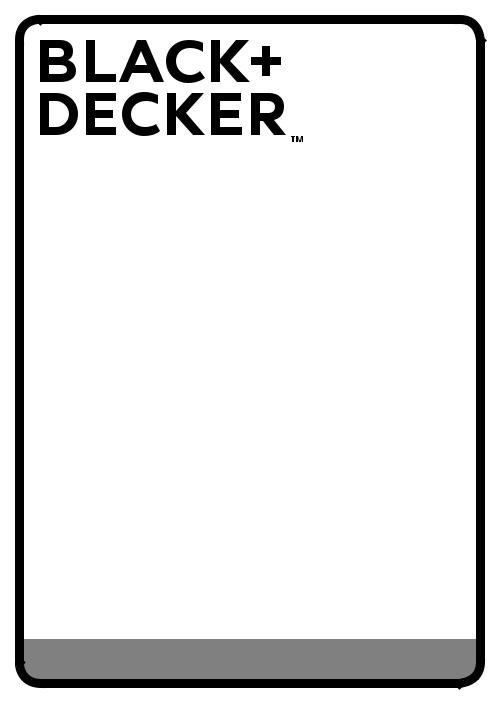
TAILLE-BORDURE / COUPE-BORDURE avec pile au lithium de 40 V max*
MODE D’EMPLOI
Numero de catalogue
LST540
Merci d’avoir choisi Black+Decker! Consulter le site Web
www.BlackandDecker.com/NewOwner pour enregistrer votre nouveau produit.
à LIRE avant de retourner ce produit pour quelque raison que ce soit :
Si des questions ou des problèmes surgissent après l’achat d’un produit Black+Decker, consulter le site Web www.blackanddecker.com/instantanswers pour obtenir des réponses instantanément 24 heures par jour. Si la réponse est introuvable ou en l’absence d’accès à l’Internet, composer le 1 800 544-6986 de 8 h à 17 h HNE, du lundi au vendredi, pour parler avec un agent. Prière d’avoir le numéro de catalogue sous la main lors de l’appel.
Pour l´achat d´un filtre de rechange composer le 1-888-678-7278
CONSERVER CE MODE D’EMPLOI POUR UN USAGE ULTÉRIEUR.
VOICI DES RENSEIGNEMENTS IMPORTANTS QU’IL VOUS FAUT
CONNAÎTRE :
• Le pare-main doit être installé avant de débuter le taillage ou la coupe sinon le moteur surchauffera.
• Utiliser seulement un fil ROND de 2 mm (0,08 po) de diamètre lors du remplacement (modèle SF-080 de B&D recommandé), sinon l’appareil ne fonctionnera pas correctement.
• Éviter de frapper la tête d’alimentation contre le sol. En effet, cela endommagera le mécanisme d’alimentation.
• Utiliser uniquement avec un bloc-piles de 36 V ou de 40 V max*
Consulter le site Web www.BlackandDecker.com/NewOwner pour enregistrer votre nouveau produit.
14
